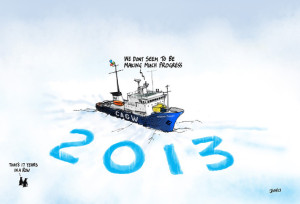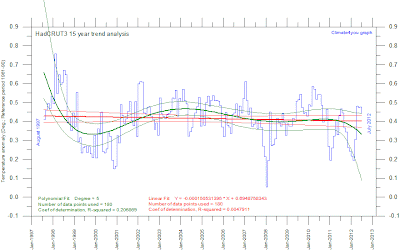Like most of the world around it, the Church of England is so caught up in busyness and anxious make-work that it has ceased to attend to what is truly happening in the world around it; and as attention is simply another word for prayer this is a grievous fault.
If the Church were to pay attention, I believe that it would perceive one immensely important fact in particular: the great idol of our time is toppling. The idol is science, or, more particularly, the idol is a particular form of scientific and technical expertise that has been shepherded by a priestly class of laboratory-coat wearing men (well – in the story that is told, mostly men) who have journeyed into the greater mysteries and emerged bearing gifts and blessings for the people.
This idolatry, this white coated religion, has its foundation myths (Galileo!) and rituals (the scientific method!), its seminaries and its churches just like any other faith. Walter Brueggemann, in writing about the prophetic imagination, notes that when Moses, the archetypal prophet, seeks to inspire the people of Israel with a belief that things do not have to be the way that they are, that it is not an eternal truth that the Israelites must be enslaved by the Egyptians, a crucial step comes when the technocrats of the Pharaoh contend with the technocrat of YHWH – and they come up short (see Exodus chapters 7-9). Each time Moses and Aaron take a step to demonstrate the power of YHWH the magicians of Egypt are able to match the demonstrations using their own powers – until they cannot. There comes a point when the powers of the establishment are no longer sufficient to provide for the people, when they are shown as no longer omnipotent and omniscient, all wise, all benevolent.
There comes a point when the god bleeds.
Which is where we are now in the West. We have experienced an immense crisis, whose ramifications are still rippling through our lives. Rippling? Maybe a rip-tide. Covid 19 – from whence did it come? Almost certainly from gain of function research in a scientific laboratory in Wuhan. From the place of expected blessing has come a curse. The cure for the curse? A white coated woman in a laboratory achieved something amazing (Sarah Gilbert) yet the issues with the mRNA style vaccines (Pfizer, Moderna) seem to only grow with time. We have embarked upon an immense social experiment, whereby fear of a contagious virus has been deliberately stoked in order to justify unprecedented levels of social control. People in England, from where I write, have for the most part gone along with this. It’s what we tend to do, this is the land of the obedient queue. Yet there comes a point when that obedience comes to an end and the Anglo-Saxon plants their feet in the ground and says ‘No’. Then the authorities have to navigate around a new reality.
(It’s what happened with Brexit.)
So the apparatus of science and the religion of technological expertise is wobbling, it is uncertain – but why am I so sure that this wobbling is in fact an incipient toppling? Because of climate change. Not so much climate change itself but the scientific and technical apparatus that surrounds it, that has been so on display in Glasgow in the COP negotiations when we do not simply see the expected hypocrisies from the great and good who jet in from overseas in order to lecture the peons on the virtue of doing without, but also in those one might reasonably expect to know better – such as the Green politician from Brighton who flew to Glasgow rather than taking the train. The gap between the ritual intonations of ‘climate change’ and the people who are being lined up to change their patterns of life is becoming increasingly large. The people are noticing more and more, and are paying more and more attention, and some time soon the tipping point will be reached and the underlying science behind the rhetoric will be brought out blinking into the light.
At which point there will be much anger. The poor are being asked to pay for the choices of the rich; I am thinking parochially – the poor in post-industrial England are being asked to change their patterns of life (gas boilers, cars), all the things on which they rely, in order to… what exactly? The claims will be of seas rising, and nations vanishing, and mass migrations and so on and so forth – yet because the cost of the changes being demanded of the poor will be so great upon the poor, the poor will rightly say ‘prove it’, and the naked panjandrums will stand blinking and mumbling and Greta will denounce the blah blah blah and the Anglo-Saxon will say ‘No’.
For the IPCC itself no longer foresees disaster under the heading of climate change. The ‘consensus’ of 97% of scientists – which is itself a falling away from the true faith, for true science has no place for ‘consensus’ – will be shown as not very interesting. The climate is warming – yes – but how dangerous is the warming, what is the best way to respond to the warming, adaptation or mitigation and most of all, with Brueggemann in mind but as Rowan Williams once phrased the single most important question in Christian political thought: “Who pays the price?”
The rich will ask the poor to change their ways but the poor will once again vote for their own betterment, and the climate will shift, in earth as in politics, and as above so below the idols will topple. The rich will use the inherited rhetoric of the scientific and technological hegemonies and they will be rejected, and the idol of science will topple with them. No longer will science be seen as the repository of blessings and wisdom; instead the intertwining of science and technology and capitalism will be rejected as a whole, from pharmaceutical exploitations to farming interventions the fundamental wrongness of the apathistic stance will be perceived and rejected – for it will be asking people to be cold in the winter, and it will have lost its power of persuasion.
I hope that we don’t face a Butlerian Jihad, for those in white coats have indeed given many blessings to the people, but for so many reasons the thought patterns of scientific and technological rationality need to be, have to be, incorporated into a larger, wiser, deeper understanding. Theology must become the Queen of the Sciences once again. In one of those little ironies of history, if in the long run we are to ensure a safe place for the Richard Dawkins of this world, it will likely only be if a recognisably Christian culture is re-established.
Else there shall be war and famine and pestilence and death – and Hell shall follow.
The idol hasn’t toppled yet, but it is moving, and wobbling, and in another year or ten or twenty it will fall, and great will be the falling of it. Then, once again, the communities of the faithful will start to pick up the pieces and seek to preserve as much as possible of the good, whilst seeking to ensure the practice of virtues that might inhibit a return to the bad. The world will continue to turn, the tides will rise and fall, and human follies shall remain inescapable.
Kyrie Eleison.





You must be logged in to post a comment.